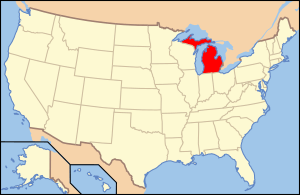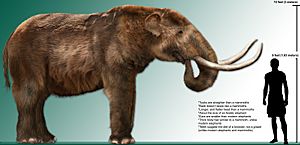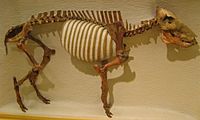Paleontology in Michigan facts for kids

Paleontology in Michigan is all about studying ancient life in the state of Michigan. This includes finding and learning about fossils found there. Michigan has a long history of life, from tiny ancient algae to huge Ice Age mammals.
Some of the oldest fossils in the world are found in Michigan's Upper Peninsula. These are tiny algae from the Precambrian time. Later, during the Paleozoic Era, Michigan was covered by a warm, shallow sea. This sea was full of amazing sea creatures like corals, brachiopods, and trilobites. Even early armored fish and sharks swam here!
Much later, during the Carboniferous Period, Michigan became a land of swamps. Then, for a very long time, not many fossils were left behind. But during the Pleistocene Ice Age, huge glaciers shaped the land. At this time, giant mammals like mammoths and mastodons roamed Michigan.
Michigan even has its own official state fossil and stone! The American mastodon is the state fossil. The Petoskey stone, which is made of fossil coral, is Michigan's state stone.
Contents
Ancient Michigan: A Journey Through Time
Life in Ancient Seas (Paleozoic Era)

Michigan's fossil story begins way back in the Precambrian time, over 540 million years ago. Tiny blue-green algae lived in the waters near what is now Lake Superior. These are some of the earliest signs of life on Earth!
During the early Paleozoic Era, Michigan was close to the equator. It was mostly covered by a warm, shallow sea. In the Cambrian Period, this sea was home to creatures like brachiopods, cephalopods (like squids), gastropods (snails), and trilobites. Trilobites became very common as time went on.
In the Ordovician Period, Michigan was still underwater. Brachiopods were everywhere, and many kinds of cephalopods swam in the seas. Some straight-shelled cephalopods grew to be more than fifteen feet long! Crinoids, which look like underwater flowers, were also common.
Even though we haven't found fish fossils from the Middle Ordovician in Michigan yet, similar rocks in nearby Ontario have yielded parts of armored fish called Astraspis. This suggests that Michigan might also have these ancient fish fossils hidden away!
During the Silurian Period, Michigan remained a marine environment. New types of corals appeared, forming thick layers up to seventy feet deep in some places.
The Devonian Period saw even more life in Michigan's seas. Crinoids were super abundant. While brachiopods were still around, they weren't as common as before. Bryozoans (tiny colonial animals) and more corals also lived here. We even find rare plant fossils from this time, like parts of the ancient tree Callixylon.
The Middle Devonian is the best time for finding ancient fish fossils in Michigan. Many discoveries have been made in the northern and southeastern parts of the state.
Armored Fish and Sharks
Many of Michigan's Devonian fish were placoderms, which were armored fish. Usually, only their bony armor and jaw bones are found. Three main groups of placoderms have been found: antiarchs, arthrodires, and ptyctodonts. Famous arthrodires like Dunkleosteus lived here.
Acanthodians were another type of fish, often found as broken spines from their fins. But the best fossils show they had large eyes and ate tiny plankton.
Sharks also swam in Michigan's Devonian seas. Since shark skeletons are made of cartilage (like your nose), they don't fossilize well. So, we usually only find their teeth and spines. Even though they lived so long ago, these ancient sharks looked a lot like modern ones!
By the Early Carboniferous Period, the sea covering Michigan slowly began to shrink. Sharks continued to live in Michigan's waters during the Mississippian Period. Gastropod and brachiopod fossils are also found from this time.
As the Carboniferous Period continued, the sea left Michigan entirely, and huge swamps formed. These swamps were filled with ancient plants like ferns, club moss trees, and horsetails. We also find fossils of xenacanth sharks and even rare burrows made by lungfish in these swamp deposits.
No Permian fossils are found in Michigan because no rocks from that time were deposited here; instead, older rocks were being worn away.
The Missing Middle (Mesozoic Era)
The Mesozoic Era, which includes the Triassic, Jurassic, and Cretaceous periods, is mostly missing from Michigan's fossil record. This is because, like the Permian, rocks from these times were either eroded away or are buried very deep.
This means that no dinosaur fossils have ever been found in Michigan. The right kind of rocks from the dinosaur age simply aren't at the surface here.
The Ice Age and Giant Mammals (Cenozoic Era)
Just like the Mesozoic, the early parts of the Cenozoic Era (the Paleogene and Neogene periods) are also missing from Michigan's fossil record. But then came the Pleistocene Ice Age, a time when huge glaciers covered much of North America.
These glaciers completely changed Michigan's landscape. They carved out the Great Lakes and filled them with melting ice. When the glaciers finally melted away between 17,000 and 13,000 years ago, they left behind a new world.
Forests of spruce and fir trees grew, and later, pine trees took over. This was a time of giant mammals! The most common Ice Age mammals found in Michigan include caribou, elk, Jefferson mammoths, American mastodons, and woodland muskoxen. Less common finds include black bears, giant beavers, and white-tailed deer.
Discovering Michigan's Past
People have been finding amazing fossils in Michigan for a long time. In 1839, the first scientifically recorded American mastodon remains were found. Later, in 1877, five ancient peccaries (pig-like animals) were discovered in a Ionia County peat bog.
In 1914, an interesting discovery was made: a fossil bone from a walrus was found near Gaylord. This showed that walruses once lived much further south than they do today!
In the 1920s and 1930s, more exciting finds happened. Scientists reported that fossils of at least two different types of mammoths had been found in Michigan. Even whale fossils were discovered! In 1927, during digging for a new school in Oscoda, a rib that might have belonged to a bowhead whale was found.
By 1940, over 117 American mastodon fossils had been found in Michigan! The 1950s brought more whale and walrus discoveries, showing how much the ancient Michigan landscape differed from today.
In the 1960s, more Jefferson mammoth and mastodon fossils were found. Scientists started keeping better track of all the discoveries, noting that 32 Jefferson mammoths had been found in Michigan by 1962.
More recently, in 1965, the Petoskey stone was named Michigan's state stone. And in 2002, the American mastodon officially became Michigan's state fossil. These designations highlight the importance of Michigan's fossil heritage.
People Who Study Fossils
Born in Michigan
- Walter Auffenberg (born 1928 in Detroit)
- Robert L. Carroll (born 1938 in Kalamazoo)
- William R. Hammer (born in Detroit)
- Nicholas Hotton III (born around 1920)
Passed Away in Michigan
- Chester A. Arnold (died 1977 in Ann Arbor)
- Claude W. Hibbard (died 1973 in Ann Arbor)
Places to Explore Fossils
Want to see real fossils and learn more? Check out these natural history museums in Michigan:
- A. E. Seaman Mineral Museum, Houghton
- Central Michigan University Museum of Cultural and Natural History, Mount Pleasant
- Cranbrook Institute of Science, Bloomfield Hills
- Kingman Museum, Battle Creek
- Michigan State University Museum, East Lansing
- University of Michigan Exhibit Museum of Natural History, Ann Arbor
Clubs for Fossil Fans
If you're interested in paleontology, you might like these groups:
- Friends of the University of Michigan Museum of Paleontology, Inc.
- Michigan Mineralogical Society




